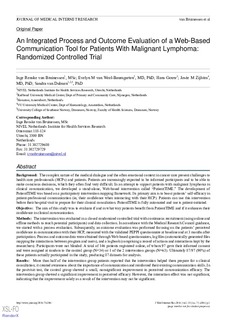| dc.contributor.author | van Bruinessen, Inge Renske | |
| dc.contributor.author | van Weel-Baumgarten, Evelyn M. | |
| dc.contributor.author | Gouw, Hans | |
| dc.contributor.author | Zijlstra, Josée M. | |
| dc.contributor.author | van Dulmen, Sandra | |
| dc.date.accessioned | 2018-02-23T10:07:27Z | |
| dc.date.available | 2018-02-23T10:07:27Z | |
| dc.date.created | 2016-12-22T10:16:36Z | |
| dc.date.issued | 2016 | |
| dc.identifier.citation | J Med Internet Res 2016, 8 (7):e206 | nb_NO |
| dc.identifier.issn | 1438-8871 | |
| dc.identifier.uri | http://hdl.handle.net/11250/2486678 | |
| dc.description.abstract | Background The complex nature of the medical dialogue and the often emotional context in cancer care present challenges to health care professionals (HCPs) and patients. Patients are increasingly expected to be informed participants and to be able to make conscious decisions, which they often find very difficult. In an attempt to support patients with malignant lymphoma in clinical communication, we developed a stand-alone, Web-based intervention called “PatientTIME.” The development of PatientTIME was based on a participatory intervention mapping framework. Its primary aim is to boost patients’ self-efficacy in patient-professional communication (ie, their confidence when interacting with their HCP). Patients can use this intervention before their hospital visit to prepare for their clinical consultation. PatientTIME is fully automated and use is patient-initiated. Objective The aim of this study was to evaluate if and in what way patients benefit from PatientTIME and if it enhances their confidence in clinical communication. Methods The intervention was evaluated in a closed randomized controlled trial with continuous recruitment (using online and offline methods to reach potential participants) and data collection. In accordance with the Medical Research Council guidance, we started with a process evaluation. Subsequently, an outcome evaluation was performed focusing on the patients’ perceived confidence in communication with their HCP, measured with the validated PEPPI questionnaire at baseline and at 3 months after participation. Process and outcome data were obtained through Web-based questionnaires, log files (automatically generated files mapping the interactions between program and users), and a logbook (comprising a record of actions and interactions kept by the researchers). Participants were not blinded. A total of 146 patients registered online, of whom 97 gave their informed consent and were assigned at random to the control group (N=34) or 1 of the 2 intervention groups (N=63). Ultimately 87/97 (90%) of these patients actually participated in the study, producing 87 datasets for analysis. Results More than half of the intervention group patients reported that the intervention helped them prepare for a clinical consultation; it created awareness about the importance of communication and reinforced their existing communication skills. In the postvisit test, the control group showed a small, nonsignificant improvement in perceived communication efficacy. The intervention group showed a significant improvement in perceived efficacy. However, the interaction effect was not significant, indicating that the improvement solely as a result of the intervention may not be significant. Conclusions A considerable number of patients reported that PatientTIME did provide support. We found a trend indicating that in the long run, patients with access to PatientTIME scored better on the perceived efficacy scale than patients without access. However, at this stage we cannot conclude that PatientTIME improves patients’ confidence when interacting with HCPs. | nb_NO |
| dc.language.iso | eng | nb_NO |
| dc.rights | Navngivelse 2.0 Internasjonal | * |
| dc.rights.uri | http://creativecommons.org/licenses/by/2.0/deed.no | * |
| dc.title | An Integrated Process and Outcome Evaluation of a Web-Based Communication Tool for Patients With Malignant Lymphoma: Randomized Controlled Trial | nb_NO |
| dc.type | Journal article | nb_NO |
| dc.type | Peer reviewed | nb_NO |
| dc.description.version | publishedVersion | nb_NO |
| dc.rights.holder | Inge Renske van Bruinessen, Evelyn M van Weel-Baumgarten, Hans Gouw, Josée M Zijlstra, Sandra van Dulmen | nb_NO |
| dc.source.volume | 18 | nb_NO |
| dc.source.journal | Journal of Medical Internet Research | nb_NO |
| dc.source.issue | 7 | nb_NO |
| dc.identifier.doi | 10.2196/jmir.5877 | |
| dc.identifier.cristin | 1416623 | |
| cristin.unitcode | 222,56,1,0 | |
| cristin.unitname | Institutt for sykepleie- og helsevitenskap | |
| cristin.ispublished | true | |
| cristin.fulltext | original | |
| cristin.qualitycode | 2 | |

